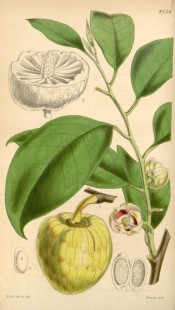Annona glabra L.
Large half hardy shrub or tree with oblong leaves, to 15cm long, and fragrant, yellow-white flowers, marked red at the base inside, followed by edible, smooth skinned, greenish-yellow fruit, variable but usually conical, blunt-ended, to about 15cm by 9cm, with highly fragrant, peachy-orange flesh, somewhat insipid tasting. Today grown as a root stock. To 10m. [RHSD, Hortus].
Horticultural & Botanical History
‘Introduced to our gardens from the West Indies by Ph. Miller in 1731, and long cultivated at Kew, where it has never flowered. For blooming specimens, and others with their rich and fragrant and tempting-looking fruit, I am indebted to Mrs. Sherbourne, of Hurst House, Prescott, a lady whose name has already appeared in these pages as the importer of rare flowering plants, but whose success in cultivating tropical fruits is, beyond anything, great; as I can testify by a recent present of such a basket of different kinds of the Citron tribe as were deemed worthy of gracing the table of royalty itself. In regard to the fruit here represented, it is only to be regretted that the flavour is not equal to its beauty. But though closely allied to the famous Cherimolia, Anona tripetala (Bot. Mag. Tab. 2011), it is scarcely eatable. Sloane indeed says, “the country people could say nothing of it, except that it was edible;” but Dr. M’c Fadyen remarks, “the fruit has a somewhat grateful smell, but to the taste it is very disagreeable, and is said to be narcotic and even poisonous.” The Alligators, according to Long, subsist at certain seasons on the fruit of this tree, and he describes them as watching for it, when ripe, to drop into the water. The wood is very light, and is employed by the negroes as a substitute for cork, to stop up the mouths of their calabashes and other rude vessels. The floats of fishing nets are also made of it. Anona palustris flowered for the first time in June, 1843, in the stove at Hurst House. The fruit here figured ripened in August, 1845.’ [BM t.4226/1846].
History at Camden Park
Listed in all published catalogues [T.57/1843]. Probably introduced to assess its potential as a fruit tree under Camden conditions.
Notes
Annona glabra Forssk. (1775) = Annona forskahlii DC., an Egyptian species.
Published Feb 23, 2009 - 03:29 PM | Last updated Jul 14, 2010 - 11:31 AM
| Family | Annonaceae |
|---|---|
| Category | |
| Region of origin | Tropical America, West Africa |
| Synonyms |
|
| Common Name | Smooth custard apple, Pond apple, Alligator apple, Cork-wood |
| Name in the Camden Park Record | Anona glabra |
| Confidence level | high |
